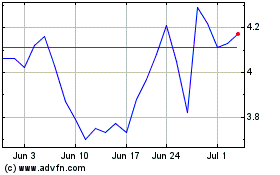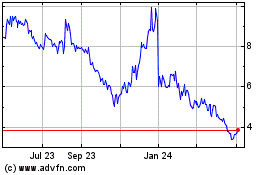Anavex Life Sciences Corp. (“Anavex” or the “Company”) (Nasdaq:
AVXL), a clinical-stage biopharmaceutical company developing
differentiated therapeutics for the treatment of Alzheimer's
disease, Parkinson's disease, schizophrenia, neurodevelopmental,
neurodegenerative, and rare diseases, including Rett syndrome and
Fragile X syndrome (FXS), a major cause of autism, today reported
positive preclinical results in directly to humans’ translatable
biomarkers for individuals with FXS for ANAVEX®2-73 (blarcamesine),
in a disease model of Fragile X syndrome (FXS).
Fragile X syndrome (FXS) is the most common form
of inherited intellectual disability and the most frequent single
gene cause of autism spectrum disorder with an estimated population
of approximately 62,500 in the US and 1,088,500 worldwide.1 It is
characterized by a range of cognitive, behavioral, and sensory
challenges, including learning difficulties, anxiety,
hyperactivity, and sensitivity to sensory stimuli. At present,
there is no approved treatment for Fragile X syndrome.
The findings presented at the 19th NFXF
International Fragile X Conference reports positive results in
directly to humans’ translatable electroencephalogram (EEG)
biomarkers present in both individuals with FXS and animal models
of FXS.
The study presented investigated the effects of
ANAVEX®2-73 on brain activity in a mouse model of FXS using
electroencephalography (EEG), a non-invasive technique that
measures electrical signals in the brain. EEG recordings from mice
treated with ANAVEX®2-73 showed significant dose-dependent
improvements in several key biomarkers of brain function compared
to untreated mice.
Key results were found in the auditory steady
state response (ASSR) EEG test, which are of particular importance
to the treatment of CNS disorders. In FXS and other CNS disorders,
the brain is unable to synchronize sensory stimuli like sounds
appropriately, driving sensory overload and hypersensitivity in
affected individuals. In the current study, ANAVEX®2-73 robustly
enhances neural synchrony in response to sounds in the frontal and
auditory cortices of the brain in a dose dependent manner.
Dysfunction of cells that regulate the balance
of excitatory-inhibitory signaling has been implicated in these
characteristic hypersensitivities of various neurodevelopmental
disorders, including FXS. This new data demonstrates that
ANAVEX®2-73 restores this balance and improves neuronal
connectivity, which is directly translatable to humans and
demonstrates the therapeutic potential of ANAVEX®2-73 to address
behavioral, sensory, and cognitive abnormalities in individuals
with FXS.
ANAVEX®2-73 has previously demonstrated
preclinical efficacy in an animal model of FXS published in the
scientific journals Nature Scientific Reports2 and the American
Journal of Medical Genetics3. These previous studies highlighted
the ability of ANAVEX®2-73 to ameliorate behavioral deficits and
fluid biomarker features of FXS. Dose-dependent treatment effect of
ANAVEX®2-73 resulted in reversal of hyperactivity, restoration of
associative learning and reduction of anxiety in a mouse model of
Fragile X syndrome, which were also associated with improvements in
key blood signaling biomarkers, which are measurable in patients
with Fragile X syndrome as well.
Based on these results, the Company plans to
initiate a clinical trial to evaluate the safety and efficacy of
ANAVEX®2-73 in individuals with FXS.
“These additional non-invasive biomarker
findings in Fragile X syndrome provide further evidence of
potential to expand the therapeutic profile of ANAVEX®2-73 into the
largest portion of addressable market of autism spectrum disorder,
Fragile X syndrome,” said Christopher U Missling, PhD, President
and Chief Executive Officer of Anavex. “We look forward to
initiating a double-blind, placebo-controlled ANAVEX®2-73 study in
Fragile X syndrome. This is further evidence of the potential of
ANAVEX®2-73 as a platform technology of precision medicine."
The poster presentation is available on the
Investors section of the Company’s website at www.anavex.com.
Anavex Life Sciences’ product portfolio platform
includes orally available small molecule drug candidate ANAVEX®2-73
for the treatment of Alzheimer’s disease, Parkinson’s disease, Rett
syndrome and ANAVEX®3-71 for schizophrenia.
About Fragile X Syndrome and Autism
Spectrum Disorder
Fragile X Syndrome is the most common form of
inherited intellectual disability and the most frequent single gene
cause of autism, affecting approximately 1 in 4,000 males and 1 in
6,000 females. The disorder is caused by the unstable expansion of
a CGG repeat in the FMR1 gene that leads to abnormal methylation
and suppression of FMR1 transcription with the resulting decrease
in protein levels in the brain and other tissues. The average age
of Fragile X syndrome diagnosis for boys and girls are 35 to 37
months and 42 months, respectively. Behavioral abnormalities,
including autism spectrum disorder, are common.
Autism spectrum disorder is a behavioral
diagnosis while Fragile X syndrome is a medical/genetic diagnosis.
Many studies have evaluated the link between Fragile X syndrome and
autism spectrum disorder over the last few decades. Since many
children with Fragile X syndrome are interested in social
interactions, they may not meet the diagnostic criteria for autism
spectrum disorder, even though they exhibit some features such as
poor eye contact, shyness, social anxiety, hand-flapping and
sensory issues. Autism is much more common in boys than in girls
with Fragile X syndrome. According to the CDC, a national parent
survey found that 46% of males and 16% of females with Fragile X
Syndrome have been diagnosed or treated for autism spectrum
disorder.
About Anavex Life Sciences
Corp.
Anavex Life Sciences Corp. (Nasdaq: AVXL) is a
publicly traded biopharmaceutical company dedicated to the
development of novel therapeutics for the treatment of
neurodegenerative, neurodevelopmental, and neuropsychiatric
disorders, including Alzheimer's disease, Parkinson's disease, Rett
syndrome, schizophrenia and other central nervous system (CNS)
diseases, pain, and various types of cancer. Anavex's lead drug
candidate, ANAVEX®2-73 (blarcamesine), has successfully completed a
Phase 2a and a Phase 2b/3 clinical trial for Alzheimer's disease, a
Phase 2 proof-of-concept study in Parkinson's disease dementia, and
both a Phase 2 and a Phase 3 study in adult patients and one Phase
2/3 study in pediatric patients with Rett syndrome. ANAVEX®2-73 is
an orally available drug candidate that restores cellular
homeostasis by targeting SIGMAR1 and muscarinic receptors.
Preclinical studies demonstrated its potential to halt and/or
reverse the course of Alzheimer's disease. ANAVEX®2-73 also
exhibited anticonvulsant, anti-amnesic, neuroprotective, and
anti-depressant properties in animal models, indicating its
potential to treat additional CNS disorders, including epilepsy.
The Michael J. Fox Foundation for Parkinson's Research previously
awarded Anavex a research grant, which fully funded a preclinical
study to develop ANAVEX®2-73 for the treatment of Parkinson's
disease. We believe that ANAVEX®3-71, which targets SIGMAR1 and M1
muscarinic receptors, is a promising clinical stage drug candidate
demonstrating disease-modifying activity against the major
hallmarks of Alzheimer's disease in transgenic (3xTg-AD) mice,
including cognitive deficits, amyloid, and tau pathologies. In
preclinical trials, ANAVEX®3-71 has shown beneficial effects on
mitochondrial dysfunction and neuroinflammation. Further
information is available at www.anavex.com. You can also connect
with the Company on Twitter, Facebook, Instagram, and LinkedIn.
Forward-Looking Statements
Statements in this press release that are not
strictly historical in nature are forward-looking statements. These
statements are only predictions based on current information and
expectations and involve a number of risks and uncertainties.
Actual events or results may differ materially from those projected
in any of such statements due to various factors, including the
risks set forth in the Company’s most recent Annual Report on Form
10-K filed with the SEC. Readers are cautioned not to place undue
reliance on these forward-looking statements, which speak only as
of the date hereof. All forward-looking statements are qualified in
their entirety by this cautionary statement and Anavex Life
Sciences Corp. undertakes no obligation to revise or update this
press release to reflect events or circumstances after the date
hereof.
For Further Information:Anavex
Life Sciences Corp.Research & Business DevelopmentToll-free:
1-844-689-3939Email: info@anavex.com
Investors:Andrew J.
BarwickiInvestor RelationsTel: 516-662-9461Email:
andrew@barwicki.com
________________________1
https://fragilex.org/understanding-fragile-x/fragile-x-101/prevalence/2
Reyes ST, Deacon RMJ, Guo SG, et al. Effects of the sigma-1
receptor agonist blarcamesine in a murine model of fragile X
syndrome: neurobehavioral phenotypes and receptor occupancy. Sci
Rep. 2021;11(1):17150. Published 2021 Aug 25.
doi:10.1038/s41598-021-94079-73 Cogram P, Deacon RMJ, Klamer D, et
al. Brain cell signaling abnormalities are detected in blood in a
murine model of Fragile X syndrome and corrected by Sigma-1
receptor agonist Blarcamesine. Am J Med Genet A.
2022;188(8):2497-2500. doi:10.1002/ajmg.a.62853
Anavex Life Sciences (NASDAQ:AVXL)
Historical Stock Chart
From Jun 2024 to Jul 2024

Anavex Life Sciences (NASDAQ:AVXL)
Historical Stock Chart
From Jul 2023 to Jul 2024
